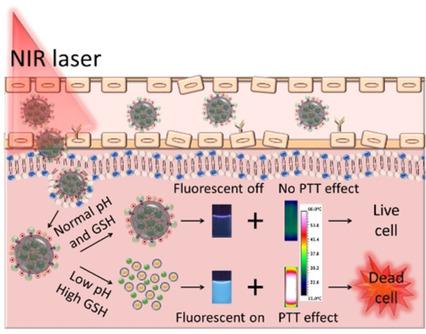当前位置:
X-MOL 学术
›
ChemMedChem
›
论文详情
Our official English website, www.x-mol.net, welcomes your
feedback! (Note: you will need to create a separate account there.)
pH/Redox‐Triggered Photothermal Treatment for Cancer Therapy Based on a Dual‐Responsive Cationic Polymer Dot
ChemMedChem ( IF 3.6 ) Pub Date : 2018-11-05 , DOI: 10.1002/cmdc.201800538 Zihnil Adha Islamy Mazrad 1 , Pham Thi My Phuong 1 , Cheong A. Choi 2 , Insik In 1, 3 , Kang Dae Lee 4 , Sung Young Park 1, 2
ChemMedChem ( IF 3.6 ) Pub Date : 2018-11-05 , DOI: 10.1002/cmdc.201800538 Zihnil Adha Islamy Mazrad 1 , Pham Thi My Phuong 1 , Cheong A. Choi 2 , Insik In 1, 3 , Kang Dae Lee 4 , Sung Young Park 1, 2
Affiliation

|
In the present study, a pH/redox‐responsive cationic polymer dot (CD) was successfully prepared for a near‐infrared (NIR)‐mediated, simultaneously controllable photothermal temperature guided imaging off/on system to monitor therapeutic delivery. Carbonized disulfide cross‐linked branched polyethyleneimine (bPEI) was conjugated with folic acid (FA) as a targeting moiety and partially formed an ionic complex with anionic indocyanine green (ICG) to afford a bPEI‐based CD (ICG‐CD). This was responsive to mild reductive (glutathione, GSH) and acidic tumor conditions, which enabled the simultaneous biodegradation of those hydrophobic and complex sites. The ICG‐CD internalized readily into the cytoplasm of cancer cells by a FA receptor and cationic‐mediated endocytosis in the off state, whereas if ICG‐CD met intracellular GSH at high concentrations, GSH contributed partially to the recovery of fluorescence and was then internalized into acidic endosomes to induce complete restoration of fluorescence. This tumor‐sensitive degradability of the CD not only facilitated ICG release in the tumor location but also allowed controllable photothermal therapy effects of nanoparticles under NIR irradiation, which resulted in improved cancer therapy. Taken together, the results indicate great potential in tumor targeting, intracellular imaging, and controllable therapeutic delivery through a fluorescence off/on assay under the pH/redox conditions of cancer cells.
中文翻译:

基于双响应阳离子聚合物点的pH /氧化还原触发光热疗法用于癌症治疗
在本研究中,成功地为近红外(NIR)介导的,同时可控制的光热温度引导成像开/关系统成功制备了pH /氧化还原响应性阳离子聚合物点(CD),以监控治疗的执行情况。碳化的二硫键交联的支链聚乙烯亚胺(bPEI)与叶酸(FA)结合作为靶向部分,并与阴离子吲哚菁绿(ICG)部分形成离子络合物,从而得到基于bPEI的CD(ICG-CD)。这对轻度还原性(谷胱甘肽,GSH)和酸性肿瘤状况有反应,这使得那些疏水和复杂位点能够同时生物降解。ICG-CD在关闭状态下容易通过FA受体和阳离子介导的内吞作用而被内化到癌细胞的细胞质中,而如果ICG-CD在高浓度下与细胞内GSH相遇,GSH部分地促进了荧光的恢复,然后被内化到酸性内体中以诱导荧光的完全恢复。CD的这种对肿瘤敏感的可降解性,不仅促进了ICG在肿瘤部位的释放,而且还使纳米粒子在NIR照射下具有可控的光热治疗效果,从而改善了癌症治疗。两者合计,结果表明在癌细胞的pH /氧化还原条件下,通过荧光关闭/开启测定,在肿瘤靶向,细胞内成像和可控的治疗递送方面具有巨大潜力。CD的这种对肿瘤敏感的可降解性,不仅促进了ICG在肿瘤部位的释放,而且还使纳米粒子在NIR照射下具有可控的光热治疗效果,从而改善了癌症治疗。两者合计,结果表明在癌细胞的pH /氧化还原条件下,通过荧光关闭/开启测定,在肿瘤靶向,细胞内成像和可控的治疗递送方面具有巨大潜力。CD的这种对肿瘤敏感的可降解性,不仅促进了ICG在肿瘤部位的释放,而且还使纳米粒子在NIR照射下具有可控的光热治疗效果,从而改善了癌症治疗。两者合计,结果表明在癌细胞的pH /氧化还原条件下,通过荧光关闭/开启测定,在肿瘤靶向,细胞内成像和可控的治疗递送方面具有巨大潜力。
更新日期:2018-11-05
中文翻译:

基于双响应阳离子聚合物点的pH /氧化还原触发光热疗法用于癌症治疗
在本研究中,成功地为近红外(NIR)介导的,同时可控制的光热温度引导成像开/关系统成功制备了pH /氧化还原响应性阳离子聚合物点(CD),以监控治疗的执行情况。碳化的二硫键交联的支链聚乙烯亚胺(bPEI)与叶酸(FA)结合作为靶向部分,并与阴离子吲哚菁绿(ICG)部分形成离子络合物,从而得到基于bPEI的CD(ICG-CD)。这对轻度还原性(谷胱甘肽,GSH)和酸性肿瘤状况有反应,这使得那些疏水和复杂位点能够同时生物降解。ICG-CD在关闭状态下容易通过FA受体和阳离子介导的内吞作用而被内化到癌细胞的细胞质中,而如果ICG-CD在高浓度下与细胞内GSH相遇,GSH部分地促进了荧光的恢复,然后被内化到酸性内体中以诱导荧光的完全恢复。CD的这种对肿瘤敏感的可降解性,不仅促进了ICG在肿瘤部位的释放,而且还使纳米粒子在NIR照射下具有可控的光热治疗效果,从而改善了癌症治疗。两者合计,结果表明在癌细胞的pH /氧化还原条件下,通过荧光关闭/开启测定,在肿瘤靶向,细胞内成像和可控的治疗递送方面具有巨大潜力。CD的这种对肿瘤敏感的可降解性,不仅促进了ICG在肿瘤部位的释放,而且还使纳米粒子在NIR照射下具有可控的光热治疗效果,从而改善了癌症治疗。两者合计,结果表明在癌细胞的pH /氧化还原条件下,通过荧光关闭/开启测定,在肿瘤靶向,细胞内成像和可控的治疗递送方面具有巨大潜力。CD的这种对肿瘤敏感的可降解性,不仅促进了ICG在肿瘤部位的释放,而且还使纳米粒子在NIR照射下具有可控的光热治疗效果,从而改善了癌症治疗。两者合计,结果表明在癌细胞的pH /氧化还原条件下,通过荧光关闭/开启测定,在肿瘤靶向,细胞内成像和可控的治疗递送方面具有巨大潜力。











































 京公网安备 11010802027423号
京公网安备 11010802027423号